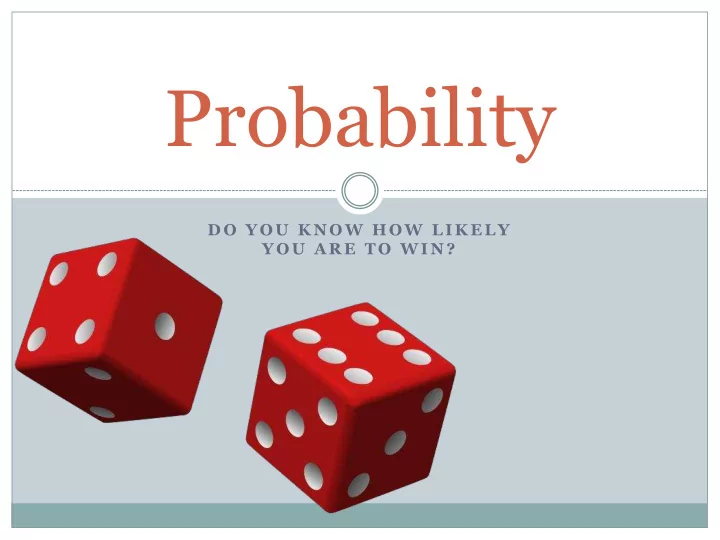

Probability D O Y O U K N O W H O W L I K E L Y Y O U A R E T O W I N ?
What is probability? Probability is: _______ the set of desired outcomes the set of all possible outcomes
A Die Example For example, a die has six sides, the side that comes up is the outcome. 6 possible outcomes with equal probabilities. What is the probability of the die coming up 4? Pr(4) /Pr(all outcomes) = 1/6. Pr(4 OR 3)= 2/6.
Counting An important part of Probability is Counting.
Counting A box has six balls in it, three are RED, and three are Blue. You draw two balls one after the other each time and put them aside. How many unique pairs you will end up with?
Counting What if the balls are numbered? 2 3 1 2 3 1 2 3 1 2 3 3 3 1 2 1 2 3 1 3 Are you starting 3 to see a pattern? Assume you Assume you Assume you get 1 and 2 get 3 and 1 get 3 and 1
Counting Once you draw the first ball, you have one less option. First ball = 6 Second ball = 5 Third ball = 4 Fourth ball = 3 Fifth ball = 2 Sixth ball = 1 (6*5*4*3*2*1) = 6! = 720 possible combinations.
Counting What if you put the numbered balls you just drew back into the box? 3 1 1 2 1 1 3 1 2 2 2 2 3 3 3 3 1 2 3 1 1 2 1 1 3 1 2 2 2 2 1 3 2 3 3 3 Assume you Assume you Assume you get 1 and 2 get 3 and 1 get 3 and 1
Counting First ball = 6 Second ball = 6 Third ball = 6 Fourth ball = 6 Fifth ball = 6 Sixth ball = 6 (6*6*6*6*6*6) = 6 6 = 46,656 possible combinations.
Pigeon Hole Principle ??? http://en.wikipedia.org/wiki/Pigeonhole_principle
Pigeon Hole Principle In mathematics and computer science, the pigeonhole principle states that if n items are put into m pigeonholes with n > m, then at least one pigeonhole must contain more than one item. http://en.wikipedia.org/wiki/Pigeonhole_principle
The Birthday Paradox What is the minimum number of people required to be in a room to guarantee two people in the room have the same birthday?
The Birthday Paradox By the pigeon hole principle, since there are 365 in a year (excluding leap years), we would need 366 people. Day 1 Day 2 http://cs.wellesley.edu/~cs199/lectures/09-birthday.html
The Birthday Paradox What is the probability that two people in a room with 50 people in it have the same birthday?
The Birthday Paradox It's a paradox not because it's logically contradictory, but because the true answer is so different from the "intuitive" answer. http://cs.wellesley.edu/~cs199/lectures/09-birthday.html
The Birthday Paradox Probability of all possible events = Total Probability = 1 When you have a “50 - 50” probability of winning: Pr(winning) =0.5 Pr(losing) = 0.5
The Birthday Paradox Pr(winning) + Pr(losing) = 0.5 + 0.5 = 1 Pr(Same Birthday) + Pr(Different Birthday) = 1 Pr(Same Birthday) = 1 - Pr(Different Birthday)
The Birthday Paradox Instead of finding Pr(Same Birthday), let’s find Pr(Different Birthday). There are 365 possible outcomes. Let person A be in the room alone. Person A could have been born on ANY day of the 365 days The probability that person A is born on a “different” day is 365/365 (remember the definition of probability?) because when you are the only person, you are sure to have a “unique” birthday.
The Birthday Paradox Person B joins person A. Person B has 364 days left to be born on. (remember we are finding Pr(different birthdays)) The probability that person B is born on a different day from person A is 364/365
The Birthday Paradox N prob 1 365/365 2 (365 x 364)/365 2 3 (365 x 364 x 363)/365 3 4 (365 x 364 x 363 x 362)/365 4 ...... 50 365 x 364 ... x 315/365 50 http://cs.wellesley.edu/~cs199/lectures/09-birthday.html
The Birthday Paradox Pr(2 people in 50 have different birthday) = = 365 x 364 ... x 315/365 50 Pr(same birthday) = 1- Pr(different birthday)
The Birthday Paradox
http://www.youtube.com/watch?v=mhlc7peGlGg
The Monty Hall Problem There are three doors, behind one of them is a car, and behind the other two are two goats. After you choose a door, the host, who knows where everything is, open a door to reveal a goat, leaving the door you chose and the third door closed. He then asks you: Would you like to switch to the other closed door? Should you switch? Stay? Or does it make no difference?
The Monty Hall Problem 3 1 2
The Monty Hall Problem Remember: ______________ Probability = the set of desired outcomes the set of all possible outcomes When we first start, there are 3 possible outcomes: 1 car, 2 goats. That means that the probability that you have selected: - A goat = 2/3. - A car = 1/3.
The Monty Hall Problem The host does not open the door at random, he knows where everything is. Hence, the odds won’t change. It is in your advantage to switch if you chose the goat door, which is the more likely event, making your winning probability 2/3 if you switch, and 1/3 if you don’t
The Monty Hall Problem goat car car car choose goat goat car goat goat
goat 1/6 goat car 1/6 goat 1/6 car goat car 1/6 1/3 car goat goat goat 1/3 car 1/3 goat goat goat 1/3
Recommend
More recommend